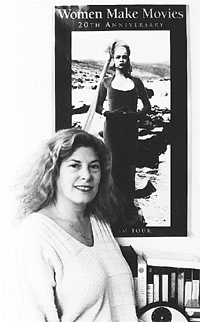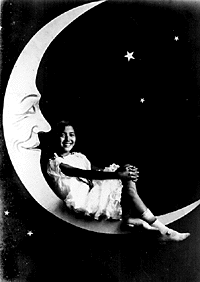Collective Projections
Women Make Movies
Fri., March 7, 1997
 Debra Zimmerman |
WMM was started in 1972 by Ariel Dougherty and Sheila Page, who conducted filmmaking workshops for women and girls out of a Chelsea church basement. Beyond the obvious financial obstacles, the group had to overcome social conditioning. "We've had to bodily drag high school girls up to a film projector to prove to them they can operate it," laughs Zimmerman. "They think it's a boy thing. The issue of technology was so strong." Workshops led to the production of a collective project in 1976, Healthcaring: From Our End of the Speculum, a women's response to the clinical "learning films" put out by the male medical establishment. When the group couldn't find a distributor, they put it out themselves; the half-hour film was a success and the collective went on to produce and distribute some 70 projects throughout the Seventies.
Like many of its supporters, Zimmerman was turned on to the group while in college. "I saw a WMM-sponsored screening put on in a barn. It was the first film that ever spoke to me, that made me realize that this is what I wanted to do." Through WMM, Zimmerman co-produced Why Women Stay, a 30-minute video exploring the complex issues surrounding women in violent homes, and went on to work in production for several years. In 1983, she returned to Women Make Movies. "I wanted to work with women, and I wanted to work in film. There was only one place to go."
"I love what I do -- it's my life's work," says Zimmerman, who has been with the organization 14 years and counting. "I feel really lucky to be doing this." Zimmerman just returned from a run of festivals which were screening works distributed by WMM. "I was at the Nordic Glory Festival in Finland, then went on to Berlin -- via Miami. I get to go all over the world, to see incredible films."
Films in the WMM collection are themselves incredible, and likely to inspire, whether through their artistry or through their content. For the most part, these are distributed for non-theatrical exhibition by colleges, libraries, museums, media arts centers, women's organizations, and community groups. This network of alternative exhibition venues allow a flexibility of programs that is impossible within the theatrical distribution system; the length and format of a film can be dictated by the needs of the content and the intent of the maker, rather than by Hollywood's demand for commercial product that runs 90 minutes to two hours, often overlooking intelligent content in favor of easily understood, formulaic stories with high production value.
The four Women Make Movies films included in the SXSW Film Festival, while representing just one percent of WMM's catalog, illustrate a strong cross-section of the group's collection. The films address issues including lesbianism, political awakening, corporate power, war crimes, and cultural and ethnic identity. Although produced in a variety of media and styles, each of the hour-long programs is linked by its underlying exploration of the formation of physical person and personal identity, and the struggle for understanding that is ultimately shared by the subject, the maker, and the audience.
Resolutely experimental filmmaker Su Friedrich's mixed-media constructions are formal to the very edge of being inaccessible. Her carefully ordered but often ambiguous, non-literal mixes of sound and image pack an emotional wallop, but once the viewer's conventional understanding of how to read media relaxes, Friedrich's images will resurface, collide, and resonate. Hide and Seek is made up of the fictional narrative of Lou -- a 1960s adolescent girl confronting her nascent feelings and society's attitudes -- intermingled with documentary footage, including 20 interviews with adult women recounting childhood experiences, over 100 photographs of lesbians as young girls, and found footage such as home movies and educational films. This poetic perspective on the role of nature versus nurture is Friedrich's attempt to "reveal the imaginary universe of young lesbians and dispel some of the myths that have darkened our dreams." Hide and Seek was made with the assistance of ITVS, and recently drew the largest audience at the Berlin Film Festival's shorts showcase.
 Halving the Bones |
Calling the Ghosts is a heart-wrenching video that puts faces behind the often sterile print coverage of the war in the Balkans. This document of damaged women becoming politicized was made over the course of three years by South African sociologist Mandy Jacobson and Croatian-American Karmen Jelcinic. The piece centers on the stories of former judge Nusreta Sivac and lawyer Jandrank Cigeli, both Muslims, who were arrested and interred for two months at the notorious Omarska detention center where they were routinely beaten, tortured, and raped by former neighbors and colleagues. Their personal struggle transformed to a larger fight for justice, ultimately leading to the United Nations classification of rape as a crime of war. Calling the Ghosts has served as a powerful advocacy tool which represents many voices and many shades of meaning. Over the fall of 1996, the film toured with its makers and "stars," who conducted workshops and teach-ins to help audiences formulate personal and practical responses.
Another issues-oriented film with a parallel function as an advocacy tool is Judith Helfand's A Healthy Baby Girl. In 1963, Helfand's mother was medically prescribed the synthetic estrogen diethylstilbestrol to ensure a healthy baby; at the age of 25, Helfand was diagnosed with DES-related cancer and underwent a radical hysterectomy. Returning to her Long Island family home to recover, Helfand began a five-year video diary that documents mother-daughter love, survival, political awakening, and community activism. Helfand and education coordinator Pamela Calvert have developed an amazing outreach and distribution system, which includes working with community groups using the film as a platform for education and activism.
Support for the audiences of independent women's media is a key role of WMM, which provides extensive curatorial assistance for exhibitors. Not to be trite, but it's a win-win situation: through the WMM Distribution Service, makers have their work shown (and collect their monthly royalty checks), while audiences are exposed to works that leave an indelible mark. "Every time I meet someone," says Zimmerman, "when we get around to saying what we do, they say, `Oh, I saw one of your movies -- it was so important to me.' That keeps me here."
Zimmerman has not spent the last 14 years simply jetting around to international film festivals. She has helped Women Make Movies grow from having two part-time employees and an operating budget of $30,000 to having six full-time and six part-time employees and an annual budget of close to a million dollars -- much of which goes directly to filmmakers in the form of royalties. The key element of this growth was the decision in the early Eighties to shift the organization's emphasis to distribution. At that time, more women were able to access the means of production; a key issue was bringing completed work to audiences.
The founding mission of Women Make Movies was to address the under-representation and misrepresentation of women in media. Their work has always presented a diversity of experiences and voices: Their catalog was multi-cultural before the word even existed. In the mid-Eighties when college campuses were scrambling for multi-cultural content, WMM had it in place and their distribution service took off.
Distribution translates into earned income -- essential to a non-profit organization's stability and power of self-determination. Although still supported in part by grants from public agencies including the NEA, the New York State Council on the Arts, and the New York City Department of Cultural Affairs, as well as private foundations such as MacArthur and Rockefeller, "grants are a nasty business these days," says Zimmerman. Through greater earned income, WMM can support a larger catalog and bring more money to more women filmmakers.
Women Make Movies also works with international organizations each year to present extended public exhibition programs and festivals featuring work from their collection. This spring, their 25th Anniversary program will visit cities throughout the world. New York's Museum of Modern Art will present a 25-program series, which WMM will augment with community-based presentations in the boroughs (harkening back to their church basement roots).
Although WMM no longer produces films in-house as it did in the Seventies, its Production Assistance program continues to support women filmmakers. A series of low-cost workshops and seminars guides women through the un-sexy side of the business, from securing funds to finalizing contracts, while the fiscal sponsorship program offers participants individualized consultation and access to information resources in addition to a non-profit umbrella for fund-raising.
Projects made under the WMM Production Assistance program have a strong track record. The Independent Television Service has funded several projects, including A Healthy Baby Girl and Hide and Seek. Other larger projects are made with studio assistance, such as Alex Sichel's All Over Me. All three of these films screened at this year's Sundance Film Festival. Additional well-known titles include The Incredible Story of Two Girls in Love, In Harm's Way, and Daughters of the Dust.
"In 1972, `Women Make Movies' was a novel statement; in 1997 it is a reality. This year, there are thousands of women making films and videos around the world," says Zimmerman in the preface to the 1997 WMM catalog. But it is still difficult for women to make large-budget films, especially to maintain control over their stories. "After Julie Dash's success with Daughters of the Dust, she was courted by Hollywood -- but they kept wanting her to make girl gang films," describes Zimmerman. "Few women in Hollywood have the power to green-light a production. Even then, they are surrounded by men -- the whole infrastructure is male-dominated." Zimmerman points out that this year at the Berlin Film Festival there were just two woman-directed feature films; at Miami, there was only one. "In 1997, that's a scandal."
"Just because their work wasn't represented at the festival doesn't mean that it doesn't exist. So many women have made films in the last 10 years," says Zimmerman. "Women need help to navigate the system and get their work out. Once it's out there, it will succeed."
Which is why Women Make Movies continues to fight the fight, and doesn't worry that being a separatist organization -- in that it distinguishes and supports by gender -- will prolong women's estrangement from mainstream structures. "Women's work is different. When you have three men selecting the program for Berlin, then it becomes that much more important to have a women's film festival in France," Zimmerman asserts. "Once there is more structural equality, maybe there will be less need."
Women Make Movies rents and sells film and video for non-theatrical exhibition, curates traveling exhibition programs, and supports women media producers. For more information, call 212/925-0606; e-mail [email protected]; or write 462 Broadway, Suite 500E, New York, NY 10013.
The SXSW Film Festival showtimes for the Women Make Movies documentaries are:
Calling the Ghosts (Tuesday, March 11, 8:15pm, Dobie III)
Halving the Bones (Sunday, March 9, 10:30pm, Dobie III)
A Healthy Baby Girl (Friday, March 7, 10:15pm, Dobie II and Monday, March 10, 8:00pm, Alamo)
Hide and Seek (Thursday, March 13, 10:30pm, Dobie III)






